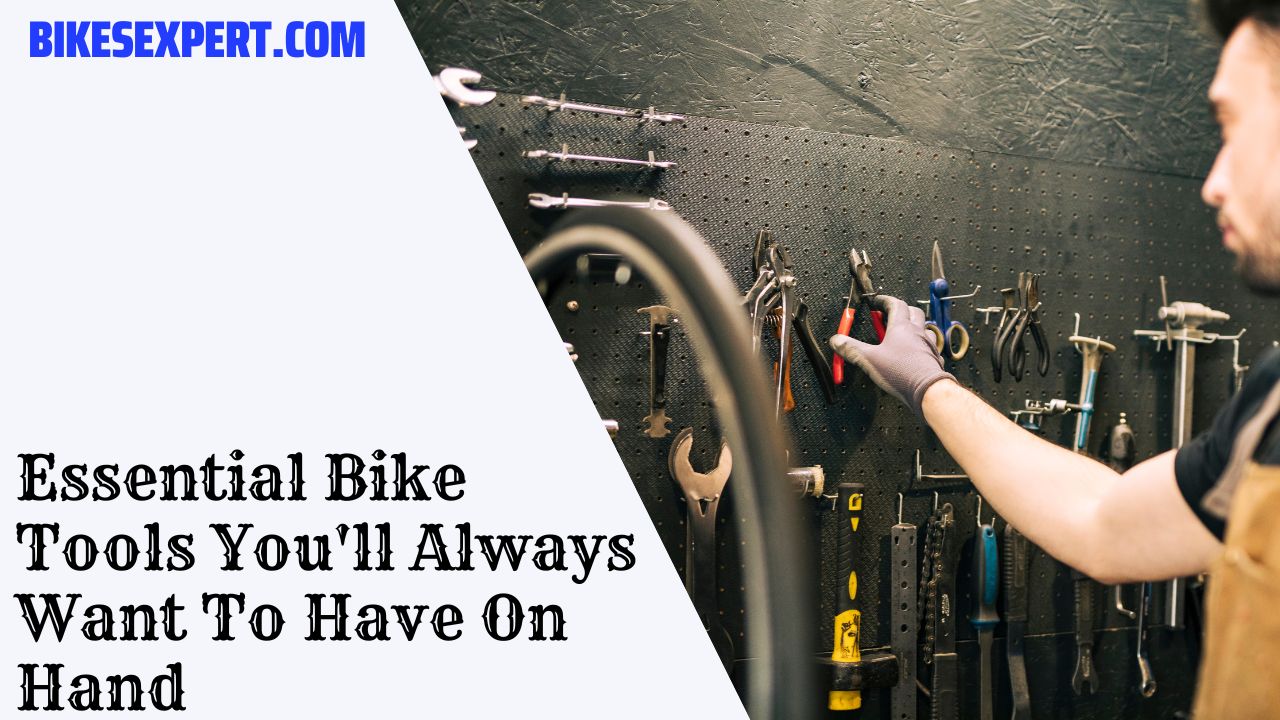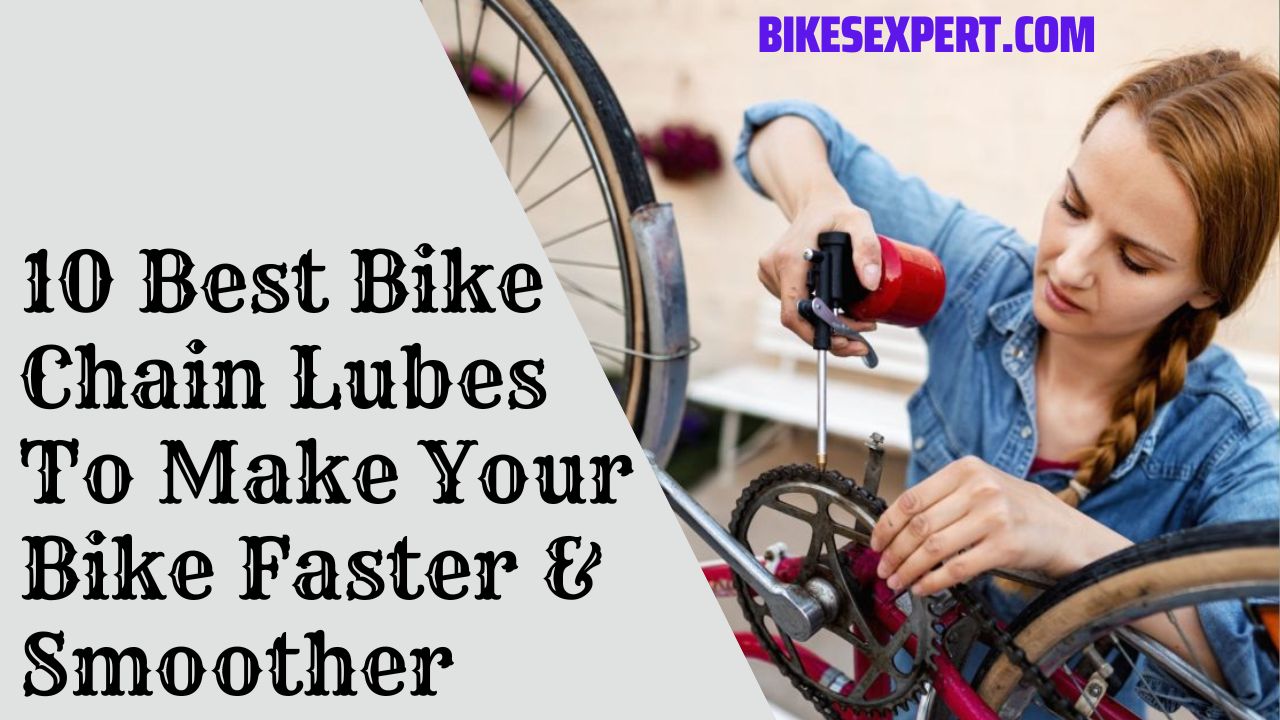You don’t need an entire bike workshop to maintain your bike. However, keeping a few simple tools on hand will allow you to do basic bike maintenance and small repairs, saving you both time and money!
Furthermore, the correct tools may assist you in salvaging a ride after small mechanical trouble or regularly keeping your bike running smoothly. These tools may be stored in your saddle bag and taken with you on a ride.
This post will go through the top ten tools that each novice or intermediate biker should have on hand. We’ll go through how and when to utilize them and some more sophisticated tools you may want to consider investing in. Let’s get this party started.
Also, you have to check out my post on Different Types Of Bike Frame Materials — Explained
Tools To Change A Bike Tire
Luckily, my first flat occurred as I rolled directly into my driveway, and I could replace it in my own house. So, ideally, you’ll never have to replace a tire while driving. However, flats can occur, and it is best to be prepared to replace a flat both on the road and at home.
1. Tire Pump
A tire pump is essential for every rider. Whether you have tubeless or tubed tires, you must check your tire pressure before every ride.
The appropriate tire pressure is printed on the sidewall of your tire. Stay ahead of riding on hard, flat terrain or with a larger rider.
On the other hand, if you’re riding in the rain or are a lightweight rider, you may keep closer to the bottom. With a little experience, you’ll be able to locate the sweet spot of just the appropriate tire pressure for you.
You’ll want a decent quality floor-style pump to keep at home, but you may also want a mini pump to carry on your bike or in your saddle pack if you have a flat on the road or trail.
2. Tire Levers

Tire levers are normally sold in three-piece sets. If you have a flat, you’ll need tire levers to lift a stubborn tire off the rim and replace the tube, so keep these in your saddle bag.
Plus, if you keep them in your backpack, you’ll always know where to find them when you need them. Tire levers should only be used for tire removal. If you use levers to mount the tire, you risk pinching the tube and causing a flat.
3. Patches

A patch kit might be beneficial if you utilize tubes in your tires. Self-adhesive patches are the most convenient to use.
They’re also convenient to carry in your saddlebag. Many bikers, however, forego the patches in favor of carrying replacement tubes.
4. Sealant and Plug Kit

If you don’t have tubes and are running tubeless tires, you should have sealant and a plug kit. Tubeless tires are fantastic because they can self-reseal if they acquire a little puncture.
However, if the puncture is too big for the sealant, a plug kit will be required to fill the hole. Plug kits are also tiny enough to fit in your saddlebag.
Tools To Work On Your Bike
Minor adjustments or repairs to your bike may be required. Here are a few things to have on hand for fast adjustments to make your journey run more smoothly.
5. Chain Wear Indicator Tool

Your chain will stretch and wear out over time. Riding a bike with a stretched or worn chain can ultimately cause damage to your cassette and chain ring, which may be costly to fix.
Even if you don’t know how to replace your chain, you should regularly utilize a chain wear indicator tool to inspect it.
When your chain shows signs of wear, you may either replace it or learn how to adjust it yourself. Changing your chain as required can help you avoid more expensive damages.
6. Allen Wrench Set

Allen wrenches are used on bicycles; you’ll need a whole set. You may be shocked at how many sizes of Allen wrenches a single bike might need.
You can change your bike when you’re out on the road or sitting at home. For example, if your seat slides while riding, you’ll need an Allen wrench to tighten it back up. If you need to alter the position of your handlebars, an Allen wrench might also assist.
It is vital to inspect your headset regularly since a loose headset may make steering safely difficult. An Allen Wrench set can tighten your bike’s headset and other loose components.
7. Torx Wrench Set

Some bike components will need a star-shaped wrench rather than an Allen wrench. A Torx wrench set is required for these fittings.
The T25 is the most critical. If you replace your brakes or chainring nuts, you’ll most likely require the T25.
8. Pedal Wrench

Pedal wrenches were first quite terrifying to me. But then I got a pair of Garmin Rally Power Meter Pedals. I had to learn to switch the pedals between my track bike and road cycle.
The pedal wrench makes removing and replacing pedals on another bike simple. Remember that certain pedals do not need a pedal wrench but a big Allen wrench (all the more reason to have a full Allen wrench set). In our shop, we utilize this simple pedal wrench.
9. Torque Wrench

When adjusting the fittings on your bike, a torque wrench monitors how much pressure, or torque, you are applying. For instance, when I change the saddle height on my
I must be cautious to avoid over- or under-tightening the bolt that supports the seat post on my Quintana Roo. Using a decent torque wrench, I can preload the proper amount of strain onto the wrench so I don’t pull out the bolt or shatter the fitting.
This is especially critical concerning carbon fiber bikes because “over-torquing” may produce a significant break that is difficult to fix. In addition, carbon is a costly material — a significant reason why bikes are so expensive these days — therefore, you should exercise extreme caution while turning nuts or screws on your carbon fiber bike.
Consider a torque wrench, a tool for tightening each screw just enough to keep the bike safe while not damaging it.
10. Multi-Tool

A multifunctional bicycle multi-tool should always be kept in your saddlebag. Then, if you’re on a ride and have a mechanical problem, you can repair it and get back home without calling an Uber.
Even if you don’t know how to use the tools, keep them with you since there’s a high possibility a riding buddy or passerby will be able to assist you if you have the tool!
That is only a small selection of tools to get you started with a basic bike toolbox. However, Trip Whitman, manager of Halter’s Cycles in Montgomery, NJ, suggests some more sophisticated equipment.
For example, he suggests a chain whip and cassette Tool for working on your cassette (rear wheel gears), Bi-Pass Cutters for cleanly cutting cables, and a Chain tool and pliers for working on chains.
More Advanced Bike Tools
It would help if you also considered adding a couple more sophisticated tools to your toolkit. Trip Whitman, manager of Halter’s Cycles in Montgomery, NJ, suggests that cyclists have more sophisticated instruments readily available.
For example, he suggests using a chain whip and cassette tool to work on your cassette (rear wheel gears), Bi-Pass Cutters to cleanly cut cables, and a Chain tool and pliers to work on chains.
11. Chain Whip and Cassette Tool

A chain whip and cassette tool are crucial to replace your cassette. A chain whip resembles a handle with a couple of chain sections attached.
To remove the cassette from your wheel, wrap the chain around it and spin it. Then you may change to a new cassette with superior climbing gears.
12. Chain Tool
A chain tool is required to modify or shorten your chain. A chain tool removes the pin that joins the chain links. For example, if you need to shorten your chain, you can push out the pin to remove links and then reconnect the chain.
13. Chain Pliers

If your bike has a master link, removing and replacing your chain will be simple with a set of chain pliers. These allow you to open and then close the link. It’s a good idea to have a tiny pair of chain pliers and an extra master link in your saddle pack.
14. Bi-Pass Cutters

The wires that control your brakes and shifters might stretch over time, causing your brakes and gears to fail.
As a result, you may need to replace your wires at some point. Bi-pass cutters will assist you in obtaining a very clean cut in this scenario so the wires don’t fray.
Other Bike Tool Considerations
15. Park Tool bike stands
All the following tools are simpler to use if you have a suitable bike stand. However, you want to avoid getting a bike stand that is unsteady or unstable. Therefore, we prefer the Park Tool bike stands since they don’t injure your bike and are solid and robust while working on it.
Finally, you should store some extra components in your toolbox. An additional bike chain, brake pads, valve cores (if your tires are tubeless), spare tubes, and stem caps are all useful to keep on hand. If you have the room, using a bike stand to work on your bike will simplify all of this maintenance!
Here is a related article that might interest you on the Best 4 Bike Repair Stands For Every Type Of Maintenance.
Frequently Asked Questions [FAQs]
What Tools Are Necessary For Cycling?
The tools you need depend on the task and your degree of expertise. We have compiled an extensive list of tools for absolute beginners, aspiring home mechanics, and expert home mechanics. Read the instructions to determine which you most closely match with, then investigate the common tools.
How Do You Wash Your Bike?
The most effective method for cleaning a bicycle is using warm, soapy water and a hose. Pressure washers might be too intense for certain sensitive areas, but scrubbing and rinsing traditionally can work wonderfully. Use a chain cleaning tool to clean the chain and a towel or sponge to clean anything else.
What Lubricant Should I Use For My Bicycle Chain?
Obtain a lubricant suited to your surroundings. There are several types, but the most crucial is choosing a wet or dry lubricant. Dry lubricant is ideal for dry, dusty situations, whereas Wet lubricant is ideal for moist, rainy areas. In Toronto, a moist lubricant prolongs chain life and increases its durability throughout the spring and autumn. Then, during the summer, when it is hot and dry, switch to a Dry lubricant that will collect less dust and remain cleaner for longer.
What Tools Do I Need To Build A Bicycle?
To construct a bicycle, you will need at least 4, 5, and 6mm Allen Keys, a Pedal wrench, a Phillips screwdriver, and a Pump. If you want to construct and maintain a bicycle, please consult the lists above for a comprehensive breakdown of all the necessary components.
Conclusion :
So, there you have it: a complete list of what tools a first-time home mechanic should get right away and what they might want to wait to buy.
Even though I couldn’t include every tool in this article, if you have the most important ones, you’ll be able to fix most things on your bike.
For example, if money and space are not an issue, you can make your garage the most popular place to hang out after a ride by going all out. You might need to add a fridge.
Here is an article that I have written about Floor Pump Makes Installing Tubeless Tires Simple.




